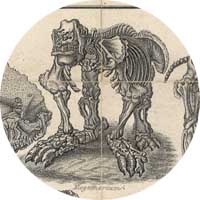
|
|
Skeleton of a Megatherium
A Megatherium was a ground sloth, the size of a modern elephant which lived during the Pliocene. Usually found in South America, this specimen was sent from Buenos Aires to Madrid in 1789 and named by Georges Cuvier in 1796.
Back to main image |
|
|
|
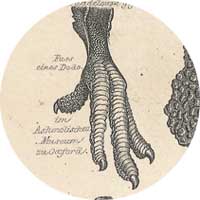
|
|
Foot of a Dodo
This dodo's foot from the Ashmolean Museum in Oxford, corresponds with the small engraving of the complete bird which appears in the original section printed in William Buckland's 'Bridgewater Treatise'. Buckland noted that the dodo had not been found alive since 1691’, however the last known sighting is thought to have been 30 years earlier.
Back to main image |
|
|
|
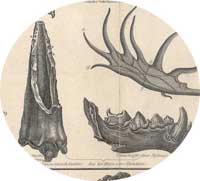
|
|
Kirkdale Cave specimens
The hyena jaw (bottom right) and tibia of an ox (left) are both from Kirkdale Cave, Yorkshire, which Buckland explored in 1822. Buckland suggested that the teeth marks and breakages on the ancient ox tibia bore similarities to the modern hyena’s method of breaking and devouring bones. He demonstrated this with a Cape hyena in Mr Wombell’s travelling collection at Oxford, December 1822.
The theory that the cave was a hyena den and the exotic animals had been dragged in as their prey won him the Royal Society's Copley medal in 1822. He published his findings in ‘Reliquiae Diluvianae' (1823).
Back to main image |
|
|
|
|
|
Vertical Section of the Gailenruth Caves, Bavaria [Franconia]
The image was based on a drawing by William Buckland during a visit to the cave complex in 1816. He discovered bones of hyenas mixed up with those of bears, which he would later compare to his more famous findings at Kirkdale Cavern in 1822.
The illustration is also from Buckland's 'Reliquiae Diluvianae' (1823).
Back to main image |
|
|
|
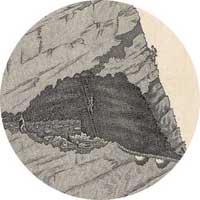
|
|
Goat’s Hole Cave
Another image taken from William Buckland's 'Reliquiae Diluvianae' (1823), Goat's Hole Cave in Gower, now known as Paviland Cave, was visited by Buckland in 1823. Again he found various animal bones such as elephant, bear, rhinoceros, horse and deer and most tellingly of all, part of a human skeleton which had been ceremonially dyed in red ochre and hence became known as the 'Red Lady of Pavilland' (shown in the image). [Subsequent analysis has shown it to be a young male skeleton.] Buckland at this time was still heavily influenced by biblical interpretations of geology, and did not consider that the human remains could be from the same geological period.
The bones he stated, were ‘clearly post-diluvian’ – that is existed after Noah’s flood.
Back to main image
|
|
|
|
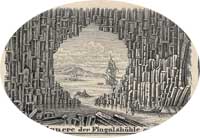
|
|
Formations of columnar basalt
Various examples of columnar basalt including this image of Fingal's Cave, Staffa.
Back to main image |
|
|
|
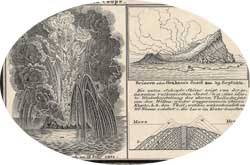
|
|
Graham's Island (or Julia's Isle or Ferdinandea or Sciacca or Nerita or Hotham or Corrao)
This image is of a submerged volcanic island which, when it temporarily appeared in July 1831 off the coast of Sicily, caused an international dispute over which country had sovereignty, as well as confusion as to its naming. In August 1831, Humphrey Fleming Senhouse, a British naval captain, claimed it for Britain and named it ‘Graham’s Island’ after Sir James Graham, first lord of the Admiralty. However when the French geologist Louis-Constant Prévost described the formation for the Société Géologique de France, he named it ‘Julia’s Isle’ after its July appearance – and it was under this name France tried to claim territorial ownership. King Ferdinand of the Two Sicilies, sent ships to ‘Ferdinandea’ to claim it for the Bourbon crown.
Charles Lyell preferred the name ‘Sciacca’ but other names put forward were Nerita, Hotham and Corrao. The island was only visible for a few months, and by December of 1831 it had disappeared – the diplomatic wrangle still unresolved.
|